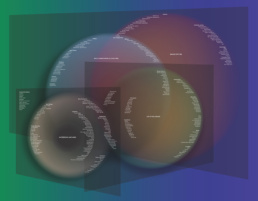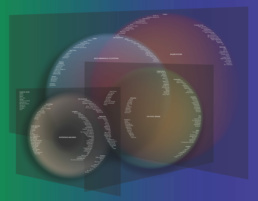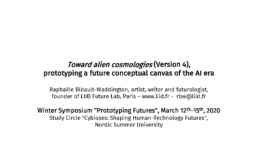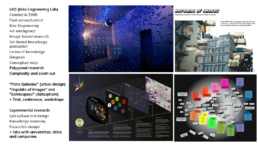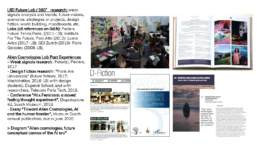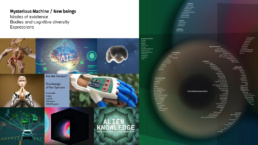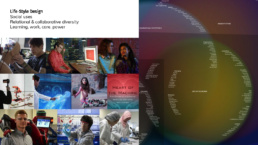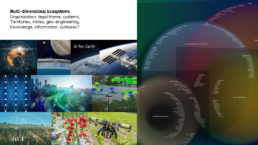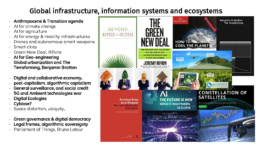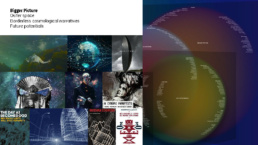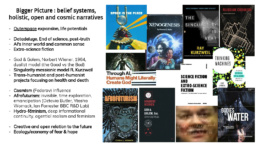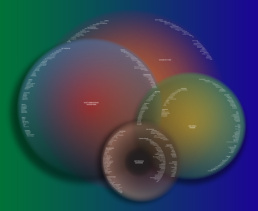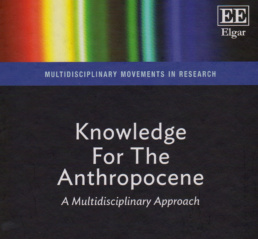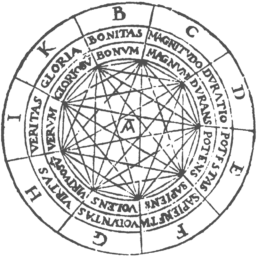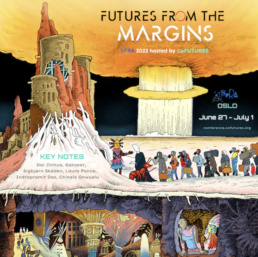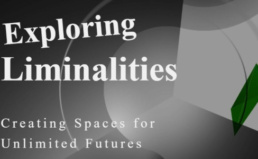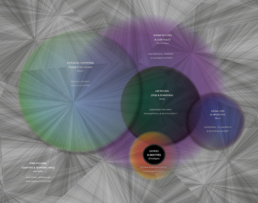‘Prototyping Futures’ Symposium, ‘Cybiosis’ Circle, NSU, Diffrakt, Berlin, 2020
Towards Alien Cosmologies
Prototyping a future conceptual canvas of the AI era
‘Prototyping Futures’ Symposium, ‘Cybiosis: Shaping Human-Technology Futures’ Study circle, Nordic Summer University, Diffrakt – Centre for Theoretical Periphery, Berlin, 2020.
Drawing conclusions from previous work on the future challenges raised by AI and its extended impact on the world, this symposium was an opportunity to prototype and discuss with an artistic and hybrid research circle, a first conceptual canvas serving as a possible tool to structure a future perspective.-
This first diagram was used to position and order prospective topics in a very fluid and exploratory manner, without specific objective. At this stage, it included 4 spheres, or 4 dimensions of the world: Mysterious Machines (human and non-human beings), Life-Style Design (Lifestyles and uses), Multi-dimensional Ecosystems (Systems and planet), and Bigger Pictures (Visions of the world).
Abstract
Toward alien cosmologies is an exploratory and incomplete conceptual canvas we started to model in 2017 in the frame of a research on the societal impacts of AI (commissioned by a future research agency), using a “weak signals” prospective methodology. AI is touching on and distorting every facets and dimensions of our existences, from the most intimate sphere to the society, the city, the economy, the law and even the planet and the space. It has become an ambiguous mirror of the human condition and of all of our uncertainties at each of theses scales.
In this new paradigm, the human is as alien as the AI, and both need new world visions (cosmologies). Toward alien cosmologies is an investigation to design new, humble and approximating anthropological futures in the AI era, using a creative and hybrid method that allows to bridge knowledge disciplines and social practices. For the symposium, we offer to briefly share the past research steps and continue the process of designing the alien cosmologies future research framework.
The live presentation will be an occasion to test and discuss with the audience its latest prototype, taking the shape of a large scale conceptual diagram, and mapping the future speculative panorama.
Following the first research step, we tested in 2018-19 with design students (Duperré School) and engineering researchers (Telecom Paris Tech), a series of (incomplete) design fiction experiments to prototype possible futures situations via indirect creative and critical experiences that still give a concrete sense of their materialization and allow to appreciating their multidimensional impacts. This prototyping method allows a concern for the broader societal and symbolic dimensions, is an alternative to pragmatic “solutionist” or object-based prototypes, and offer new possibilities to prototype at the large scale (eg. organizations, cities, worlds) or in the conceptual realm (as we do).
These experiments dialog with more theoretical and multi-disciplinary investigations to be shared in conferences such as at Susch Muzeum (Switzerland) and a long essay in the museum annual publication due soon. As in the diagram, classic theories (philosophy, anthropology, ecology, digital humanities) entangle with more fringe fields (afro-futurism, hydro-feminism, dataism).
RBW
Intervention slides
About "Prototyping Futures", Nordic Summer University Winter Symposium
Symposium organised by NSU Study Circle #2: Cybioses – Shaping Human-Technology Futures
SCIENTIFIC / ORGANIZATION TEAM : Palle Dahlstedt, Rafael Dernbach and Maru Mushtrieva
In our previous symposia, we have examined improvisation, creativity, and projection as key practices of shaping futures: when is improvisation required in making or imagining futures? Can creativity be automated? And how can projecting into the future prevent us from repeating and prolonging what already exists today?
For our fourth symposium, we want to examine the practice of prototyping. Building a prototype means creating an incomplete sample or model to test an idea. Prototyping usually has two features: firstly, it demonstrates the feasibility of an idea. Often this occurs by translating conceptual knowledge to experiential knowledge: what has worked in theory becomes visible and palpable and then hopefully works in practice as well.
And secondly, prototyping accelerates a production process. The incompleteness, small scale or limited functionality of a prototype allows for an accelerated test. Simply said, the quickest way to build something is to build something else.
About NSU Study Circle ‘Cybioses’ : www.nsuweb.org/study-circles/circle-2-cybioses-life-in-the-future-imperfect/
Research axes reminder
Axis 1: Transitions & Future Worlds
Axis 2: Foresight Methodology Innovation
Axis 3: Art & Future Research
Related articles
Towards Alien Cosmologies, prospective topology of a refoundation…, FHAP#4, 2020
This article offers a grand tour through the movements of the world and the critical future challenges they raise in…
Designing Post-Human Futures, Knowledge for the Anthropocene, 2021
This long essay lays the basis of TAC Future Lab methodological and transdisciplinary research, mixing learnings from…
Ethics & Philosophy of Futures, Association of Professional Futurists, 2022
RBW introduced here the different philosophical references that irrigate the work of TAC Future Lab, whether in its…
The Future as a moving panorama, Sci-Fi Research Association, University of Oslo, 2022
Science Fiction raises today strong interest for its ability to stage future worlds, whether utopian or dystopian. The…
TAC World-building, 25th World Future Studies Federation Conference, Paris, 2023
This conference shows how the TAC Future Canvas was designed, how it rearticulates other tools and conceptual models…
limit/no limit, Art & Design Research Conference, Paris, 2024
RBW zooms in on the TAC Future Lab work related to knowledge, whether it be the cognitive value of artistic formats,…
